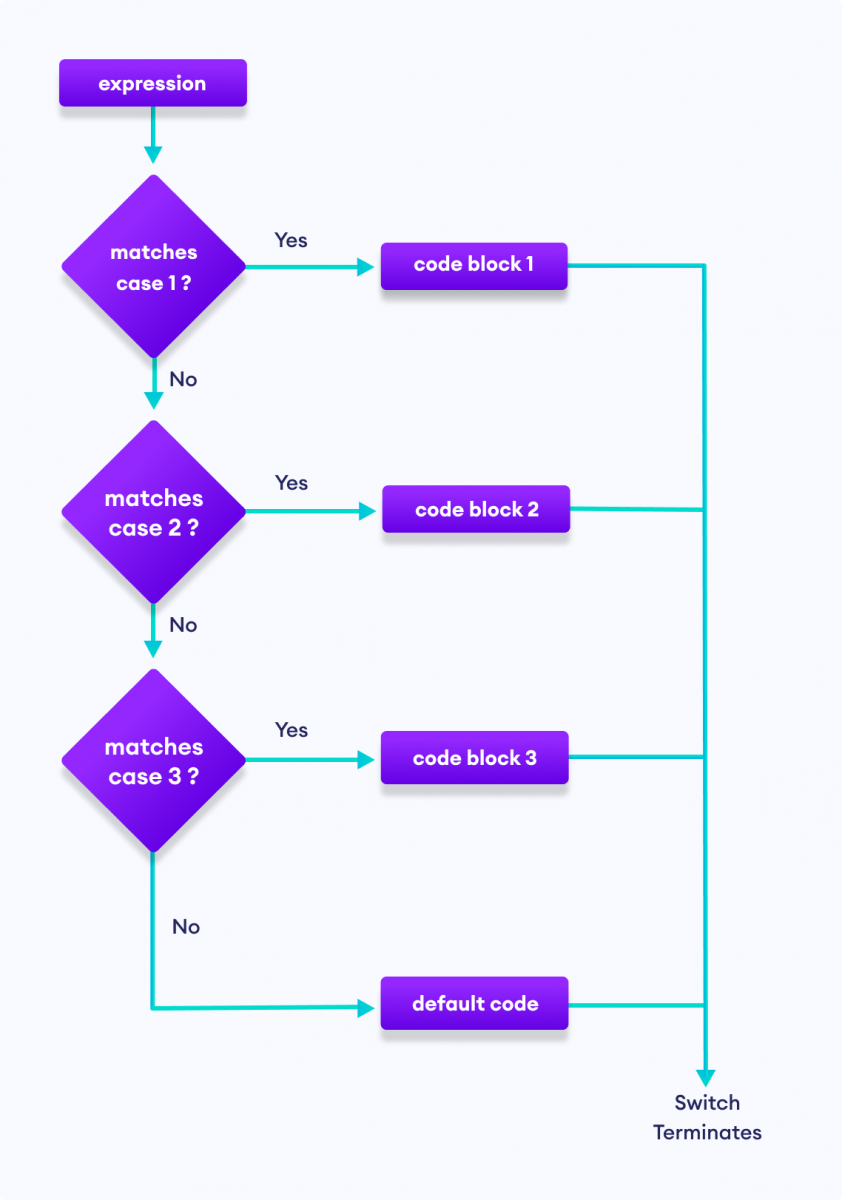switch 语句允许我们在许多备选项中执行一个代码块。
Swift 中 switch 语句的语法是
switch (expression) {
case value1:
// statements
case value2:
// statements
...
...
default:
// statements
}switch 语句计算括号 () 内的表达式。
- 如果表达式的结果等于
value1,则执行case value1:的语句。 - 如果表达式的结果等于
value2,则执行case value2:的语句。 - 如果没有匹配项,则执行 **default case** 的语句。
注意: 我们可以使用 if...else...if 阶梯来实现相同的功能。但是,switch 语句的语法更简洁,更易于阅读和编写。
Switch Statement 的流程图

示例 1:使用 Switch 语句的简单程序
// program to find the day of the week
let dayOfWeek = 4
switch dayOfWeek {
case 1:
print("Sunday")
case 2:
print("Monday")
case 3:
print("Tuesday")
case 4:
print("Wednesday")
case 5:
print("Thursday")
case 6:
print("Friday")
case 7:
print("Saturday")
default:
print("Invalid day")
}输出
Wednesday
在上面的示例中,我们将 4 赋值给 dayOfWeek 变量。现在,变量会与每个 case 语句的值进行比较。
由于该值与 case 4 匹配,因此执行 case 中的语句 print("Wednesday"),程序终止。
带有 fallthrough 的 Switch 语句
如果在 case 语句中使用 fallthrough 关键字,即使 case 值与 switch 表达式不匹配,控制也会继续到下一个 case。例如,
// program to find the day of the week
let dayOfWeek = 4
switch dayOfWeek {
case 1:
print("Sunday")
case 2:
print("Monday")
case 3:
print("Tuesday")
case 4:
print("Wednesday")
fallthrough
case 5:
print("Thursday")
case 6:
print("Friday")
case 7:
print("Saturday")
default:
print("Invalid day")
}输出
Wednesday Thursday
在上面的示例中,由于该值与 case 4 匹配,因此执行 case 中的语句 print("Wednesday")
我们还使用了 fallthrough 关键字。因此,即使 case 不匹配 case 语句,case 5 中的语句 print("Thursday") 也会被执行。
示例 2:带有范围的 Switch 语句
let ageGroup = 33
switch ageGroup {
case 0...16:
print("Child")
case 17...30:
print("Young Adults")
case 31...45:
print("Middle-aged Adults")
default:
print("Old-aged Adults")
}输出
Middle-aged Adults
在上面的示例中,我们为每个 case 使用了数字范围,而不是单个值:case 0...16、case 17...30 和 case 31...45。
这里,ageGroup 的值为 33,落在范围 32...45 内。因此,执行语句 print("Middle-aged Adults")。
Switch 语句中的元组
在 Swift 中,我们也可以在 switch 语句中使用 元组。例如,
let info = ("Dwight", 38)
// match complete tuple values
switch info {
case ("Dwight", 38):
print("Dwight is 38 years old")
case ("Micheal", 46):
print("Micheal is 46 years old")
default:
print("Not known")
}输出
Dwight is 38 years old
在上面的示例中,我们创建了一个名为 info 的元组,值为:"Dwight" 和 38。
这里,每个 case 语句不仅包含单个值,还包含元组:case ("Dwight", 38) 和 case ("Micheal", 46)。
现在,info 的值与每个 case 语句进行比较。由于该值与 case ("Dwight", 38) 匹配,因此执行语句 print("Dwight is 38 years old")。
要了解有关元组的更多信息,请访问 Swift 元组。